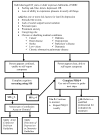Late-life depression detection
- PMID: 25633861
- PMCID: PMC4440549
- DOI: 10.3928/00989134-20150115-01
Late-life depression detection
Abstract
The disability associated with late life depression makes it an important target for screening. Identifying clinically significant depression symptoms in older adults who have known risk factors provides an important opportunity for early evaluation and treatment. Screening that leads to evaluation and treatment is critical to both preventing depression, and reducing the associated disability, symptom burden, and costs of major depressive disorders (MDD). The guideline described here recommends the 9-item Patient Health Questionnaire (PHQ-9) for screening because it is based on diagnostic criteria for MDD and has the advantages of being brief, self-administered, easily scored and interpreted, and reliable and valid in diverse populations and care settings. Nurses and allied health professionals who provide care to older adults across the continuum of care are uniquely positioned to identify at risk older adults, use depression screening scales, make needed referrals for evaluation and treatment, and monitor outcomes across time.
Similar articles
-
Evidence-based practice guideline: wandering.J Gerontol Nurs. 2014 Nov;40(11):16-23. doi: 10.3928/00989134-20140911-01. Epub 2014 Oct 15. J Gerontol Nurs. 2014. PMID: 25310096 No abstract available.
-
Caring for Depression in Older Home Health Patients.J Psychosoc Nurs Ment Health Serv. 2015 Nov;53(11):25-30. doi: 10.3928/02793695-20151021-01. J Psychosoc Nurs Ment Health Serv. 2015. PMID: 26535761 Free PMC article.
-
Assessing and managing depression in older people.Nurs Times. 2013 Oct 30-Nov 5;109(43):16-8. Nurs Times. 2013. PMID: 24369578
-
Recognizing late-life depression: why is this important for nurses in the home setting?Geriatr Nurs. 2005 May-Jun;26(3):145-9. doi: 10.1016/j.gerinurse.2005.03.020. Geriatr Nurs. 2005. PMID: 15973340 Review. No abstract available.
-
Recommendations for mental health care of older adults: Part 1--an overview of depression and anxiety.J Gerontol Nurs. 2009 Feb;35(2):26-34. doi: 10.3928/00989134-20090201-03. J Gerontol Nurs. 2009. PMID: 19263919 Review.
Cited by
-
Understanding the Interplay between Air Pollution, Biological Variables, and Major Depressive Disorder: Rationale and Study Protocol of the DeprAir Study.Int J Environ Res Public Health. 2023 Mar 15;20(6):5196. doi: 10.3390/ijerph20065196. Int J Environ Res Public Health. 2023. PMID: 36982103 Free PMC article.
-
Factors associated with depression detection in a New Hampshire mental health outreach program.Aging Ment Health. 2018 Nov;22(11):1471-1476. doi: 10.1080/13607863.2017.1364346. Epub 2017 Aug 16. Aging Ment Health. 2018. PMID: 28812372 Free PMC article.
-
Prevalence of risk factors for dementia in middle- and older- aged people registered in Primary Health Care.Dement Neuropsychol. 2021 Apr-Jun;15(2):239-247. doi: 10.1590/1980-57642021dn15-020012. Dement Neuropsychol. 2021. PMID: 34345366 Free PMC article.
References
-
- Acee AM. Detecting and managing depression in type II diabetes: PHQ-9 is the answer! Medsurg Nurs. 2010;19(1):32–38. - PubMed
-
- Alexopoulos GS, Abrams RC, Young RC, Shamoian CA. Cornell Scale for Depression in Dementia. Biological Psychiatry. 1988;23(3):271–284. - PubMed
-
- Almeida OP, Alfonso H, Pirkis J, Kerse N, Sim M, Flicker L, et al. A practical approach to assess depression risk and to guide risk reduction strategies in later life. Int Psychogeriatr. 2011;23(2):280–291. - PubMed
-
- Anstey KJ, von Sanden C, Sargent-Cox K, Luszcz MA. Prevalence and risk factors for depression in a longitudinal, population-based study including individuals in the community and residential care. Am J Geriatr Psychiatry. 2007;15(6):497–505. - PubMed
MeSH terms
Grants and funding
LinkOut - more resources
Full Text Sources
Other Literature Sources
Medical


